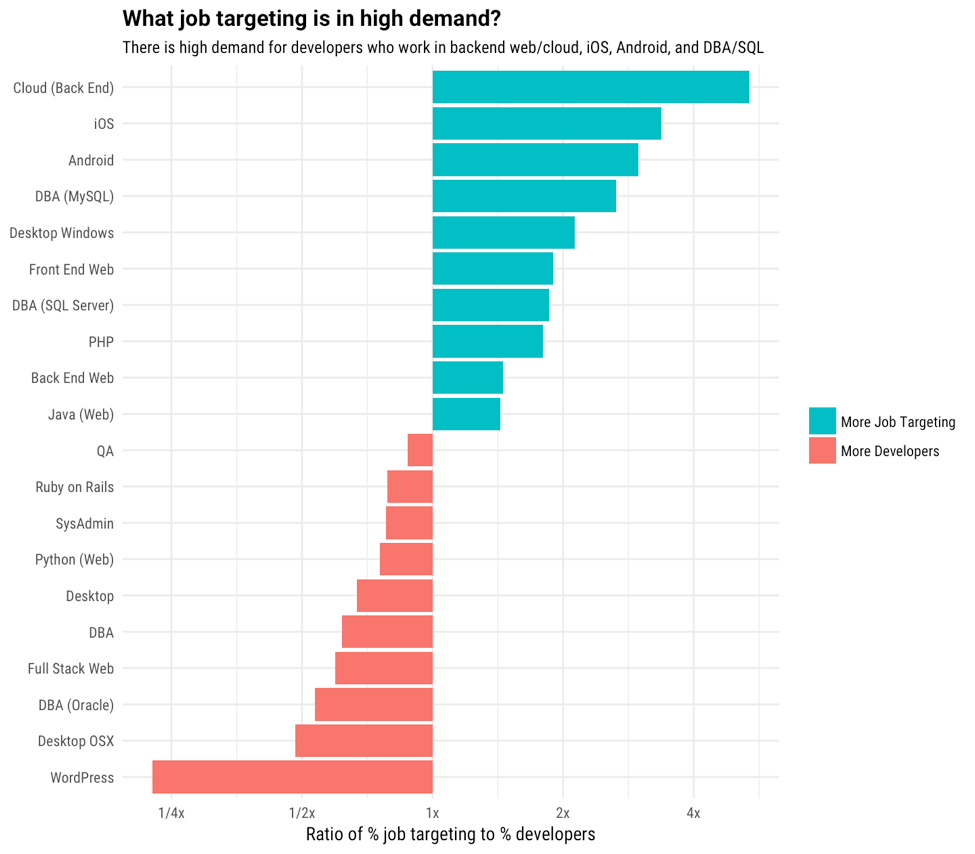If you’ve been following AgileEngine, you’ve probably seen our reports on the top outsourcing countries to watch in 2014 and 2013. In the past years, we’ve been busy establishing new nearshore development centers in Kiev and Buenos Aires and building awesome products for global brands. I guess that explains the three-year lull, but now it’s time for a new collection of stats.
Just like in 2014 and 2013, we’ll explore the major nearshore and offshore destinations in Eastern Europe, Asia Pacific and South America. Besides, we’ll take a quick look at the state of software development outsourcing in 2018.
The state of software development in 2018
StackOverflow reports that in the 2018’s software development job market, demand still outpaces the supply. Look at the chart below, and you’ll see why hiring software developers often takes 3–5 months in the US.

So what can you do to attract the best developers in today’s market? Given that senior software engineers earn an average annual salary of $114,470, few companies can afford paying above the market.
Perks used to work in the past, but today, everyone offers them. Expecting to lure people in with additional days off? Adobe’s employees get four-weeks sabbaticals. How about workplace catering? Twitter offers 3 meals a day, theatrical classes, and on-site acupuncture.
Sure, most companies don’t compete with Adobe or Twitter directly, but the whole situation certainly makes the best developers hard to impress. That’s the bad news and the reality we have to embrace.
Top reasons to outsource software development in 2018
There are good news, too. There’s still an option to find talented programmers fast — if you’re ready to hire remote software developers. According to a survey from Statistics Brain, 43% of US companies are outsourcing programming jobs. The same survey highlighted nine major benefits of offshore outsourcing that motivate companies to hire overseas talent:
- Cost reduction (or better control over expenses) was the number-one reason for 44% of respondents (CTOs and CEOs from US-based companies).
- Access to the IT talent that’s unavailable within the company — 34% of respondents.
- Freeing up the workforce within the company — 31%.
- Improvement of the company’s business and/or customer focus — 28%.
- Acceleration of the company’s digital transformation or reorganization — 22%.
- Faster project development — 15%.
- Access to the management expertise unavailable within the company — 15%.
- Reduction of time to market — 9%.
As of today, the number of computer programming jobs being outsourced by American companies exceeds 211,000. Giants like Cisco, Oracle, and Samsung have been tapping into the global talent pool for decades. All of these brands are outsourcing software development in Ukraine, Poland, or other nearshore destinations. This raises the same-old question: where should you outsource?
Top outsourcing countries in 2018
Below are 14 software development outsourcing destinations that we’ll compare based on their billing rates, market size, and a slew of other factors.
| Eastern Europe | South America | Asia Pacific |
|---|---|---|
| Poland | Brazil | China |
| Romania | Mexico | Philippines |
| Ukraine | Argentina | India |
| Russia | Colombia | Malaysia |
| Czech Republic | Vietnam |
Billing rates
The primary driving force behind outsourcing and offshoring, the price gap between western countries and offshore outsourcing locations is gradually narrowing down. This said, cost reduction remains one of the key advantages of outsourcing internationally. Today, outsourcing software development in Ukraine, Poland or, say, Argentina can still save you about 30–50% of the cost of a local hire.
The table below compares the 14 top outsourcing countries based on the average billing rates that offshore software development companies charge.
| Avg cost per hour ($) | juniour | middle | senior | QA | architect |
|---|---|---|---|---|---|
| Brazil | 41 | 46 | 56 | 40 | 66 |
| Mexico | 33 | 40 | 52 | 39 | 59 |
| Argentina | 34 | 41 | 53 | 39 | 58 |
| Colombia | 41 | 45 | 58 | 40 | 62 |
| China | 20 | 24 | 31 | 24 | 31 |
| Philippines | 21 | 28 | 37 | 30 | 47 |
| India | 17 | 21 | 26 | 20 | 30 |
| Malaysia | 26 | 34 | 46 | 33 | 50 |
| Vietnam | 14 | 17 | 20 | 17 | 22 |
| Poland | 31 | 37 | 50 | 33 | 59 |
| Romania | 33 | 42 | 58 | 39 | 59 |
| Ukraine | 30 | 36 | 47 | 33 | 50 |
| Russia | 25 | 32 | 42 | 32 | 44 |
| Czech | 35 | 41 | 54 | 39 | 56 |
Historically famous for its large pool of low-cost programmers, India holds status of one the most inexpensive outsourcing destinations. On the flip side, the quality of code produced in this location has been a concern for years. Combined with the language and time barrier, this has led to a growing number of companies opting for more expensive nearshore outsourcing locations.
Market size (approximate number of developers in the 14 outsourcing destinations)
A gradual expansion of the software developers demographic is one of the prominent engineering outsourcing trends. The stats below represent approximate numbers UI, full-stack, mobile, enterprise, and game developers from the 14 top outsourcing countries.
- Brazil — 66,000
- Mexico — 30,000
- Argentina — 28,000
- Colombia — 9,000
- China — 39,000
- Philippines — 35,000
- India — 630,000
- Malaysia — 15,000
- Vietnam — 18,000
- Poland — 43,000
- Romania — 30,000
- Ukraine — 43,000
- Russia — 45,000
- Czech Republic — 22,000
Innovation index
Innovation-friendly socioeconomic environment benefits the quality of software engineering services offered in a particular location. Global tech brands often prioritise software development companies from the most innovation-friendly economies. The table below covers the top outsourcing countries that rank among the Bloomberg’s top-50 most innovative economies. Note that not all of the 14 outsourcing destinations are on the Bloomberg’s list.
| Rank | Country | Total Score | High-tech intensity | R&D intensity | Productivity | Manufacturing value-added | Tertiary efficiency | Researcher concentration | Patent activity |
|---|---|---|---|---|---|---|---|---|---|
| 21 | China | 68.89 | 9 | 15 | 43 | 19 | 43 | 43 | 7 |
| 22 | Poland | 67.47 | 22 | 35 | 35 | 16 | 15 | 35 | 24 |
| 23 | Malaysia | 66.98 | 21 | 27 | 37 | 12 | 26 | 34 | 33 |
| 26 | Russia | 65.24 | 24 | 31 | 42 | 48 | 3 | 27 | 16 |
| 28 | Czech Republic | 62.27 | 0 | 16 | 33 | 4 | 38 | 24 | 26 |
| 38 | Romania | 57.06 | 25 | 49 | 41 | 14 | 31 | 46 | 35 |
| 42 | Ukraine | 50.78 | 34 | 44 | 50 | 47 | 4 | 44 | 27 |
| 46 | Brazil | 46.4 | 30 | 29 | 45 | 46 | 50 | 50 | 47 |
| 49 | Argentina | 44.62 | 0 | 46 | 44 | 28 | 47 | 41 | 48 |
Programmer skill rankings
The HackerRank Programming Olympics and the TopCoder rating are the two rankings that offer a glimpse of how skilled developers are across locations.
| Country | HackerRank | TopCoder Rank |
|---|---|---|
| Brazil | 38 | 15 |
| Mexico | 33 | 35 |
| Argentina | 39 | 17 |
| Colombia | 45 | 37 |
| China | 1 | 2 |
| Philippines | – | – |
| India | 31 | 12 |
| Malaysia | 47 | – |
| Vietnam | 23 | 11 |
| Poland | 3 | 4 |
| Romania | 20 | 16 |
| Ukraine | 11 | 5 |
| Russia | 2 | 1 |
| Czech Republic | 9 | 26 |
Attrition rates
Attrition rates have a direct impact on developer retention, which is an important metric for any kind of business. Surprisingly, there’s been little change in the attrition rates across the 14 outsourcing destinations over the past years.
| Country | Average attrition rate |
|---|---|
| Brazil | 15 |
| Mexico | 12 |
| Argentina | 25 |
| Colombia | 18 |
| China | 27 |
| Philippines | 19 |
| India | 27 |
| Malaysia | 16 |
| Vietnam | 23 |
| Poland | 15 |
| Romania | 14 |
| Ukraine | 11 |
| Russia | 11 |
| Czech Republic | 15 |
Communications and cultural compatibility
Often viewed as inherent problems of outsourcing, cultural gap and language barrier can hamper communication in distributed teams.
There’s one thing to note, as far as cultural and language factors go. The English proficiency and cultural compatibility of developers from high-ranking software outsourcing companies are significantly higher than their countries’ averages. Still, average levels are useful for companies seeking to establish remote offices for R&D and software development. There are two indexes indicative of these averages.
| Country | EF EPI | Cultural compatibility (Gartner) |
|---|---|---|
| Brazil | 50.66 | ★★★★★ |
| Mexico | 49.88 | ★★★★★ |
| Argentina | 58.4 | ★★★★☆ |
| Colombia | 48.41 | ★★★★☆ |
| China | 50.94 | ★★★★☆ |
| Philippines | 60.33 | ★★★★★ |
| India | 57.3 | ★★★★★ |
| Malaysia | 60.7 | ★★★★☆ |
| Vietnam | 54.06 | ★★★★☆ |
| Poland | 61.49 | ★★★★★ |
| Romania | 58.14 | ★★★★☆ |
| Ukraine | 50.62 | ★★★★★ |
| Russia | 52.32 | ★★★★☆ |
| Czech Republic | 59.09 | ★★★★★ |
Timezones
Time gap presents another item on the list of potential problems with outsourcing to other countries. Having 3–4 hours overlapping between location is enough for most remote Agile teams to stay highly efficient. Experienced software engineers remain productive while dealing with larger time gaps, but team management typically requires additional effort under these conditions.
The infographic below compares the time zone of the 14 outsourcing locations to Eastern Standard Time:
| Eastern Standard Time | 8 a.m. | 6 p.m. | Overlapping working hours |
|---|---|---|---|
| Brazil | 9 a.m. | 7 p.m. | 8 |
| Mexico | 7 a.m. | 5 p.m. | 8 |
| Argentina | 9 a.m. | 7 p.m. | 8 |
| Colombia | 7 a.m. | 5 p.m. | 8 |
| China | 8 p.m. | 6 a.m. | 0 |
| Philippines | 8 p.m. | 6 a.m. | 0 |
| India | 5.30 p.m. | 3.30 a.m. | 0.5 |
| Malaysia | 8 p.m. | 6 a.m. | 0 |
| Vietnam | 7 p.m. | 5 a.m. | 0 |
| Poland | 2 p.m. | 12 p.m. | 5 |
| Romania | 3 p.m. | 1 a.m. | 4 |
| Ukraine | 3 p.m. | 1 a.m. | 4 |
| Russia | 4 p.m. | 2 a.m. | 3 |
| Czech Republic | 2 p.m. | 12 p.m. | 5 |
Bottom line: where do you outsource?
The short (and obvious) answer is: there’s no one-size-fits-all software outsourcing destination. Low-cost offshore locations like India might work for waterfall-oriented companies seeking to outsource routine tasks. In the meantime, nearshore locations with higher innovation indexes are better-suited for Agile and more tech-intensive projects.
In case Ukraine or Argentina look like the outsourcing destination that your company is likely to consider, contact us and tell us about your project. The AgileEngine dev centers in these strategic locations are home to top-3% developers well-versed in UI, full-stack, mobile, and enterprise software development.




